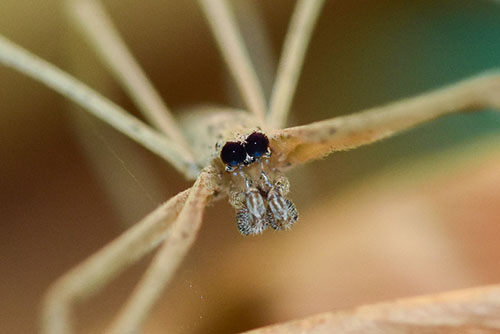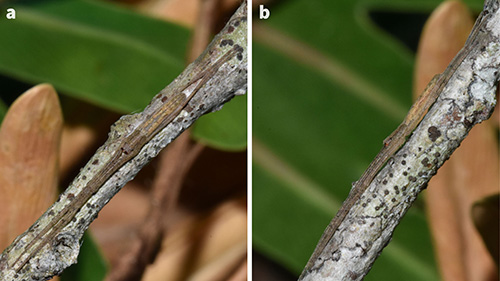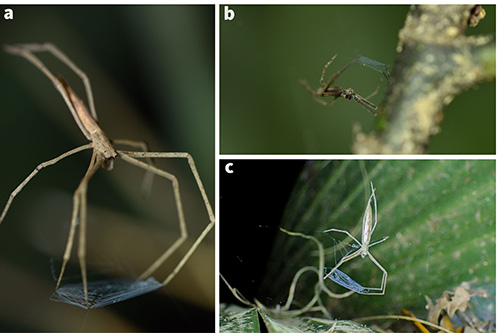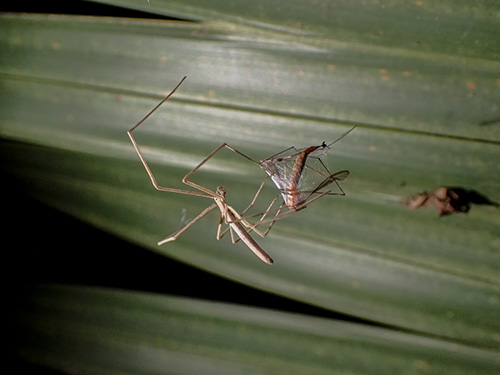common name: ogre-faced spider, net casting spider, gladiator spider
scientific name: Deinopis spinosa (Marx, 1889) (Arachnida: Araneae: Deinopidae)
Introduction - Description and Identification - Distribution and Habitat - Nocturnal Foraging - Predators and Prey - Mating Behavior - Economic Importance - Selected References
Introduction (Back to Top)
Deinopis spinosa, commonly known as an ogre-faced spider or gladiator spider, is in the net-casting spider family (Family: Deinopidae) found in the southeastern United States, the Caribbean, and South America (Bradley 2013, Stevenson et al. 2018). Deinopis spinosa is strictly nocturnal, mimicking a dead twig during the daylight hours (Getty and Coyle 1996). After sunset, Deinopis spinosa uses a unique ‘net-casting’ foraging strategy to capture prey (Coddington and Sobrevila 1987).
Description and Identification (Back to Top)
The ogre-faced spider is a medium-sized spider (total body length of approximately 10-17mm) that gets its common name from its remarkably large forward-facing posterior median eyes (the two largest of its eight eyes) (Bradley 2013) (Fig. 1). These eyes are the largest eyes of any spider, with huge photoreceptors (the parts of the eye that capture light) that provide exceptional sensitivity to help them hunt at night (Land and Nilsson 2012). Relative to body size, the diameter of the posterior median eye is significantly smaller in mature males compared to immature males and females of all life stages (Stafstrom et al. 2017).
Figure 1. Anterior view of male Deinopis spinosa (Marx) showing the large posterior median eyes. Photograph by Laurel B. Lietzenmayer, University of Florida.
Deinopis spinosa has a long, slim body and legs that closely resemble the brown coloration and irregular, multicolored pattern of a dead twig (Getty and Coyle 1996) (Fig. 2). Mature males tend to be slightly less cryptic in posture and form than mature females (Stafstrom et al. 2017). Immature male Deinopis spiders closely resemble females, however the mature male can be distinguished by its large, bulbous pedipalps, extremely thin abdomen, and exceptionally long legs (Blest and Land 1977). During the day, when resting in their twig-like posture, they look superficially like other twig-like spiders (e.g., Miagrammopes spp. (family Uloboridae), Tetragnatha spp. (family Tetragnathidae). However, these other spider groups all have relatively small eyes, compared with the unmistakably large forward-facing eyes of Deinopis spinosa.
Figure 2. Deinopis spinosa (Marx) exhibiting cryptic posture and form from a) dorsal view and b) lateral view. Photographs by Laurel B. Lietzenmayer, University of Florida.
Distribution and Habitat (Back to Top)
Deinopis spinosa is distributed across the coastal plain region of the southeastern United States (Stevenson et al. 2018) as well as the Caribbean and South America (Bradley 2013). Due to their cryptic nature, they are particularly difficult to find in the field, especially during the day (Getty and Coyle 1996). They are not known to be habitat specific and have been found in an array of terrestrial habitats including coastal hammocks, oak (Quercus) and pine (Pinus) forests, and close to swamps and marshes (Stevenson et al. 2018).
Nocturnal Foraging (Back to Top)
Unlike most web-building spiders, that mostly rely on vibrational cues in the web to detect prey, Deinopis spiders rely heavily on their enlarged, light-sensitive posterior median eyes for visual cues to detect passing prey at night (Stafstrom et al. 2017). In fact, the posterior median eyes of Deinopis spiders absorb about 2000 times more light than Phidippus jumping spiders, who are also known for their unusually large eyes but hunt during the day (Blest and Land 1977).
At nightfall, Deinopis spiders abandon their sticklike camouflage to construct a non-sticky frame of silk from which they hang upside down. With their front three pairs of legs, they hold a rectangular capture web made from cribellate (woolly) silk (Stafstrom 2017) (Fig. 3). They actively manipulate this web and use it like a net to capture both walking and flying prey (Getty and Coyle 1996), which is successful about 50% of the time (Stafstrom and Hebets 2016). Deinopis spinosa visually recognizes walking insects and subsequently captures them by propelling the capture net downward to entangle the prey. Flying insects create air vibrations, which can also be detected by Deinopis spinosa, allowing the spider to launch the net upward in the direction of the prey (Strafstrom et al. 2020). Once the prey has been caught, Deinopis spinosa twitches the capture web several times to ensure the entanglement of the insect, and then uses its free hind legs to pull out silk from its spinnerets to wrap up the prey, biting the prey once or several times throughout this process before feeding can begin (Foelix 2011) (Fig. 4).
Figure 3. Net-casting hunting position of Deinopis spinosa (Marx). a) note silk strands in capture net, b) juvenile with net-casting web, c) full body view of common net-casting position. Photographs by Laurel B. Lietzenmayer, University of Florida.
Figure 4. Deinopis spinosa (Marx) capturing a crane fly and wrapping it in silk. Photograph by Laurel B. Lietzenmayer, University of Florida.
Predators and Prey (Back to Top)
Deinopis spinosa assumes an anti-predator posture while at rest during the day. At dawn (usually around 5 a.m.) Deinopis spiders retract their capture web and settle into their cryptic, stick-like form. Most often, this position is assumed on or near and parallel to some type of concealment structure, which is usually a twig or vine. However, sometimes Deinopis spiders may be positioned well away from any substrate, relying more on their ability to mimic a twig than being concealed by one (Getty and Coyle 1996). Deinopis spiders are generalist predators and have been observed eating an array of walking and flying prey items, including crickets (Stafstrom et al. 2017), roaches, and beetles (Getty and Coyle 1996). There is little to no documentation on the predators of Deinopis spiders, but the potential for predation by birds or monkeys was noted in one study (Getty and Coyle 1996).
Mating behavior (Back to Top)
Upon reaching sexual maturity, male Deinopis spinosa undergo sudden morphological and behavioral changes. The size of the male’s posterior median eyes is significantly reduced, and the net-casting behavior is lost (Stafstrom et al. 2017). Mature males no longer hunt for prey and instead actively search for mates (Stafstrom et al. 2017). Mature males do not rely on vision when searching for mates, but rather are attracted to airborne cues from mature females (Stafstrom et al. 2017). In many cases, males are more likely to find females in complete darkness than in the light (Stafstrom et al. 2017). The fact that visual cues are not necessary for successful mate-searching in Deinopis spinosa may explain the reduced diameter of the posterior median eyes of mature males (Stafstrom and Hebets 2019).
Economic Importance (Back to Top)
Deinopis spinosa currently has no economic importance, though studies of their silk may have potential applications for bioengineering. Spider silk is becoming an increasingly studied biomaterial for its superior strength and elasticity. Spiders of the family Deinopidae produce cribellate silk, or non-viscous adhesive silk (Eberhard and Pereira 1993), meaning that the silk itself is a dry adhesive. This is unlike the dominant capture silk of most orb- and cobwebs, which is coated in a sticky glue (Michalik et al. 2019). This adhesive silk is highly complex, with its threads being composed of several different types of interwoven fibers, each contributing to its ability to stretch and adhere to different surfaces (Michalik et al. 2019). Studying and understanding the remarkable characteristics of the cribellate silk of Deinopis spinosa and other cribellate spiders may allow reverse-engineering of silk-inspired materials which can be beneficial to humans, with numerous applications in biomedicine, textiles, and electronics (Lefevre and Auger 2016).
Selected References (Back to Top)
- Blest AD, Land MF. 1977. The physiological optics of Dinopis subrufus L. Koch: A fish-lens in a spider. Proceedings of the Royal Society of London. Series B. Biological Sciences 196: 197-222. https://doi.org/10.1098/rspb.1977.0037
- Bradley RA. 2013. Common Spiders of North America. University of California Press, Berkeley, CA. 271 pp. https://doi.org/10.1525/9780520954502
- Coddington J, Sobrevila C. 1987. Web manipulation and two stereotyped attack behaviors in the ogre-faced spider Deinopis spinosus Marx (Araneae, Deinopidae). Journal of Arachnology 15: 213-225.
- Eberhard W, Pereira F. 1993. Ultrastructure of cribellate silk of nine species in eight families and possible taxonomic implications (Araneae: Amaurobiidae, Deinopidae, Desidae, Dictynidae, Filistatidae, Hypochilidae, Stiphidiidae, Tengellidae). Journal of Arachnology 21: 161-174.
- Foelix RF. 2011. Biology of Spiders. Oxford University Press, USA, 432 pp.
- Getty RM, Coyle FA. 1996. Observations on prey capture and anti-predator behaviors of ogre-faced spiders (Deinopis) in southern Costa Rica (Araneae, Deinopidae). Journal of Arachnology 24: 93-100.
- Land MF, Nilsson DE. 2012. Animal Eyes. Oxford University Press. Oxford, England. 2nd ed. 288 pp.
- Lefèvre T, Auger M. 2016. Spider silk inspired materials and sustainability: perspective. Materials Technology 31: 384-399. https://doi.org/10.1179/1753555715Y.0000000065
- Michalik P, Piorkowski D, Blackledge TA, Ramírez MJ. 2019. Functional trade-offs in cribellate silk mediated by spinning behavior. Scientific Reports 9: 9092. https://doi.org/10.1038/s41598-019-45552-x
- Stafstrom JA, Hebets EA. 2016. Nocturnal foraging enhanced by enlarged secondary eyes in a net-casting spider. Biology Letters 12: 20160152. https://doi.org/10.1098/rsbl.2016.0152
- Stafstrom JA, Michalik P, Hebets EA. 2017. Sensory system plasticity in a visually specialized, nocturnal spider. Scientific Reports 7: 46627. https://doi.org/10.1038/srep46627
- Stafstrom JA. 2017. Sensory Ecology of the Net-Casting Spider, Deinopis spinosa (dissertation). ProQuest, Ann Arbor, MI.
- Stafstrom JA, Hebets EA. 2019. Male attraction to female airborne cues by the net-casting spider, Deinopis spinosa. Behavioural Processes 159: 23-30. https://doi.org/10.1016/j.beproc.2018.12.014
- Stafstrom JA, Menda G, Nitzany EI, Hebets EA, Hoy RR. 2020. Ogre-faced, net-casting spiders use auditory cues to detect airborne prey. Current Biology 30: 5033-5039. https://doi.org/10.1016/j.cub.2020.09.048
- Stevenson DJ, Brown GD, Chandler H, Daniel DD, Garza C, McWhorter M, Moore M, Thomas A. 2018. Recent noteworthy distribution records for Deinopis spinosa (Marx, 1889) (Araneae: Deinopidae) in the southeastern United States. Southeastern Naturalist 17. https://doi.org/10.1656/058.017.0209



